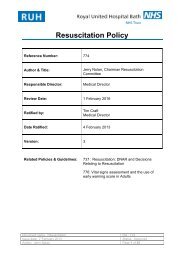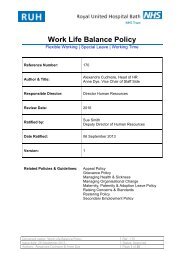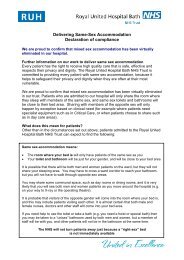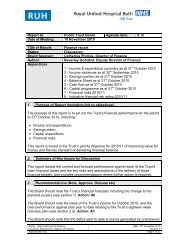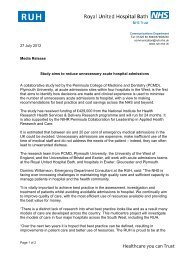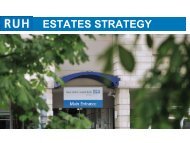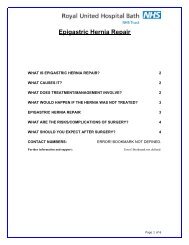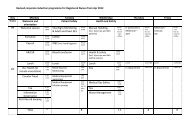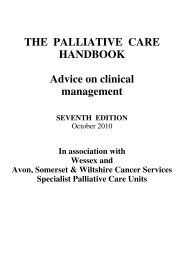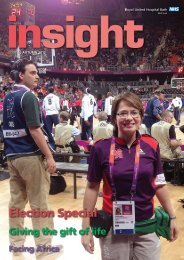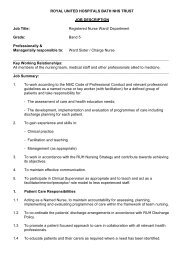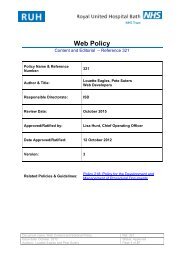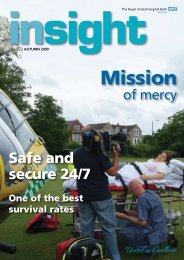Annual Report - Royal United Hospital Bath NHS Trust
Annual Report - Royal United Hospital Bath NHS Trust
Annual Report - Royal United Hospital Bath NHS Trust
You also want an ePaper? Increase the reach of your titles
YUMPU automatically turns print PDFs into web optimized ePapers that Google loves.
<strong>Royal</strong> <strong>United</strong> <strong>Hospital</strong> <strong>Bath</strong> <strong>NHS</strong> <strong>Trust</strong><br />
<strong>Annual</strong> <strong>Report</strong> 2009/10<br />
Page 1<br />
RUH <strong>Annual</strong> <strong>Report</strong> 2009/10
RUH <strong>Annual</strong> <strong>Report</strong> 2009/10 Page 2
Contents<br />
Financial Review 2009/10 4<br />
Financial duties and measures in 2009/10 6<br />
Future financial plans 10<br />
<strong>Trust</strong> Board Membership 12<br />
Remuneration <strong>Report</strong> 14<br />
<strong>Annual</strong> Accounts 2009/10 18<br />
Directors’ Interests 21<br />
Appendix 1 Summary Financial Statements (Audited) 22<br />
Statement on Internal Control 27<br />
Statement of the Chief Executive’s responsibility<br />
as the accountable officer of the <strong>Trust</strong> 34<br />
Statement of Directors’ responsibility in respect of the accounts 35<br />
Independent auditor’s statement to the Board of Directors of<br />
<strong>Royal</strong> <strong>United</strong> <strong>Hospital</strong> <strong>Bath</strong> <strong>NHS</strong> <strong>Trust</strong> 36<br />
Glossary 38<br />
Page 3<br />
RUH <strong>Annual</strong> <strong>Report</strong> 2009/10
Financial Review 2009/10<br />
Context<br />
The <strong>Royal</strong> <strong>United</strong> <strong>Hospital</strong> <strong>Bath</strong> <strong>NHS</strong> <strong>Trust</strong> (RUH) met<br />
its objective of working within available financial<br />
resources for 2009/10. The year was the fourth<br />
consecutive one in which we have generated<br />
surpluses of income over expenditure. The surpluses<br />
have been used to repay the RUH’s long term loan<br />
from the Department of Health.<br />
A summary of the RUH financial performance<br />
over the past four years is set out below. Historic<br />
information for 2006/07 and 2007/08 is based on<br />
UK Generally Accepted Accounting Principles (UK<br />
GAAP). Information for 2008/09 and 2009/10 is<br />
based on International Financial <strong>Report</strong>ing Standards<br />
(IFRS). This is in response to the Department of<br />
Health’s requirement that the <strong>NHS</strong> is compliant<br />
with the requirements of IFRS as applicable to the<br />
<strong>NHS</strong>. Consequently, balances may not be directly<br />
comparable between financial years.<br />
Our financial performance is a huge achievement for<br />
the RUH and credit must be paid to all our staff for<br />
the part they have played in this.<br />
UK GAAP basis<br />
IFRS basis<br />
Historical financial information<br />
2006/07<br />
£000<br />
2007/08<br />
£000<br />
2008/09<br />
£000<br />
2009/10<br />
£000<br />
Revenue 177,820 194,221 210,149 223,356<br />
Pay expenditure (114,494) (119,376) (127,435) (137,640)<br />
Non pay expenditure (67,650) (68,401) (72,040) (78,145)<br />
Operating surplus 4,324 6,444 10,674 7,571<br />
Net finance costs and dividends (4,180) (4,544) (4,884) (6,173)<br />
Net surplus 144 1,900 5,790 1,398<br />
Adjustments to arrive at the <strong>Trust</strong>’s Statutory Breakeven Duty<br />
Impact of transfer to IFRS 0 0 (190) 0<br />
Reversal of impairments 0 0 1,805 4,402<br />
Position against Breakeven duty 144 1,900 7,405 5,800<br />
Figure 1: The <strong>Trust</strong>’s financial performance<br />
2006-2010<br />
RUH <strong>Annual</strong> <strong>Report</strong> 2009/10 Page 4
The change in the RUH surplus from 2008/09 to<br />
2009/10 is explained by the chart below:<br />
For 2010/11, the RUH is aiming to make a surplus of<br />
£6.0m in order to make its planned loan repayment to<br />
the Department of Health. The RUH must implement<br />
and deliver its planned savings in 2010/11 in order to<br />
achieve this.<br />
Details of our financial plans are closely monitored by<br />
the <strong>Trust</strong> Board every month, and have been regularly<br />
reviewed by the Strategic Health Authority, <strong>NHS</strong><br />
South West.<br />
Copies of our <strong>Trust</strong> Board papers are available on our<br />
web site, along with details of times and venues for<br />
the Public meetings.<br />
£'m<br />
20.0<br />
18.0<br />
16.0<br />
14.0<br />
12.0<br />
10.0<br />
8.0<br />
6.0<br />
4.0<br />
2.0<br />
0.0<br />
7.4<br />
Surplus against<br />
breakeven duty (2008/09)<br />
1.8<br />
Impairments<br />
11.7<br />
10.2<br />
3.4<br />
0.2 0.7<br />
1.7<br />
1.1<br />
5.6 5.8 1.2 1.6<br />
5.8<br />
2008/09 surplus<br />
(UK GAAP)<br />
Impact of IFRS<br />
2008/09 surplus (IFRS)<br />
Additional patient<br />
care PCT/DH income<br />
Figure 2: Changes contributing to the <strong>Trust</strong>’s surplus in 2009/10<br />
1.4<br />
Additional<br />
education income<br />
Additional staff costs<br />
Additional non-staff<br />
costs<br />
A bridge chart is a graphical method used to explain movements from one position to another. In this<br />
chart, the black bars represent a position for the <strong>Trust</strong> at a point in time, with green bars explaining<br />
positive movements (either as increased income or reduced expenditure) in the <strong>Trust</strong>’s financial<br />
position, and red bars explaining negative movements (either as reduced income or increased<br />
expenditure).<br />
Additional contributions to Clinical<br />
Negligence Scheme for <strong>Trust</strong>s<br />
Additional net finance<br />
costs and dividends<br />
Reduction in depreciation<br />
Reduction in purchase of healthcare<br />
from outside the <strong>NHS</strong><br />
Other net changes<br />
Surplus against<br />
breakeven duty (2009/10)<br />
4.4<br />
Impairments<br />
1.4<br />
2009/10 surplus (IFRS)<br />
Page 5<br />
RUH <strong>Annual</strong> <strong>Report</strong> 2009/10
Financial duties and measures in<br />
2009/10<br />
The RUH met its statutory financial duties in 2009/10<br />
as follows:<br />
Meeting the planned surplus<br />
We achieved our target of a planned revenue<br />
surplus of £5.8m (in 2008/09 the <strong>Trust</strong> achieved its<br />
planned surplus of £5.6m on a UK GAAP basis, which<br />
translated into £5.8m on an IFRS basis).<br />
The RUH final reported surplus was £1.4m because<br />
its expenditure included impairments totalling £4.4m;<br />
this expenditure is not included in the calculation of<br />
our planned surplus or its break-even duty.<br />
By meeting this target, we achieved our statutory<br />
breakeven duty and ensured that our in-year<br />
expenditure did not exceed our income.<br />
External financing limit (EFL)<br />
The EFL sets out how the RUH manages its cash flow<br />
and borrowing requirements. During 2009/10 we<br />
were able to manage within our cash requirements,<br />
and met this target (2008/09: target met).<br />
Capital resource limit (CRL)<br />
In addition, the RUH is measured against the<br />
following targets:<br />
Capital cost absorption rate<br />
The RUH is required to make a return on the<br />
assets it employs of 3.5%. In previous years, the<br />
calculation was based on forecast assets and dividend<br />
payments for the financial year. During 2009/10, this<br />
methodology was amended, and it is now based on<br />
actual assets held through the year; the RUH then<br />
pays 3.5% of this value as its dividend payment. The<br />
RUH achieved its required return of 3.5% (2008/09:<br />
2.5%).<br />
Management costs<br />
The RUH is required to record its management costs<br />
according to parameters set by the Department<br />
of Health and to state these in relation to relevant<br />
income.<br />
The CRL is the maximum amount that the <strong>Trust</strong> can<br />
invest in fixed assets during the year. In 2009/10 we<br />
did not exceed our CRL (2008/09: CRL not exceeded).<br />
RUH <strong>Annual</strong> <strong>Report</strong> 2009/10 Page 6
2009/10 2008/09<br />
£000 £000<br />
Management Costs 8,738 8,734<br />
Income 223,170 210,150<br />
Cost as a percentage of income 3.9% 4.2%<br />
Management costs and related income figures are as defined by the Department for Health.<br />
Better payment practice code - Measure of<br />
compliance<br />
2009/10 2008/09<br />
Number Number<br />
Total Non-<strong>NHS</strong> trade invoices paid in the year 65,513 68,775<br />
Total Non <strong>NHS</strong> trade invoices paid within target 62,257 61,286<br />
Percentage of Non-<strong>NHS</strong> trade invoices paid within target 95% 89%<br />
Total <strong>NHS</strong> trade invoices paid in the year 2,452 2,407<br />
Total <strong>NHS</strong> trade invoices paid within target 2,250 2,140<br />
Percentage of <strong>NHS</strong> trade invoices paid within target 92% 89%<br />
The Better Payment Practice Code requires the RUH to aim to pay all undisputed invoices by the<br />
due date or within 30 days of receipt of goods or a valid invoice, whichever is later. The <strong>Trust</strong> places<br />
great importance on ensuring that valid invoices are paid quickly, and is a signatory to the Prompt<br />
Payment Code www.promptpaymentcode.org.uk. The Prompt payment code requires that at least<br />
95% of valid invoices are paid within 30 days of receipt.<br />
Page 7<br />
RUH <strong>Annual</strong> <strong>Report</strong> 2009/10
Our monthly performance in achieving the target in 2009/10 has been as follows:<br />
100<br />
90<br />
94<br />
96 95 95<br />
91<br />
96 95<br />
93<br />
95<br />
92<br />
96 96<br />
80<br />
70<br />
%<br />
60<br />
50<br />
40<br />
30<br />
20<br />
April<br />
May<br />
June<br />
July<br />
August<br />
September<br />
October<br />
November<br />
December<br />
January<br />
February<br />
March<br />
Figure 3 2009/10 performance under the Better Payment Practice Code<br />
Historic Deficit, Breakeven Duty and Legacy Debt<br />
The <strong>Trust</strong> has demonstrated financial stability since 2006/07, but it has a substantial historic accumulated deficit<br />
within Retained Earnings (formerly, the Income and Expenditure Reserve), standing at £44.4m at 31 March<br />
2010.<br />
Legislation requires the <strong>Trust</strong> to breakeven ‘taking one year with another’. In 1997, guidelines were issued by<br />
the Department of Health on how this should be measured in practice. Adjustments are required to remove<br />
certain transactions from the in-year financial surplus or deficit to compare against the <strong>Trust</strong>’s breakeven duty.<br />
Consequently, there are differences between the historic accumulated deficit and the breakeven duty deficit,<br />
as detailed below. The position stated for years up to, and including, 2008/09 are on a UK GAAP basis. The<br />
position for 2009/10 is on an IFRS basis.<br />
RUH <strong>Annual</strong> <strong>Report</strong> 2009/10 Page 8
In Year (Deficits)/<br />
Surpluses £000<br />
Breakeven Duty £000<br />
1992/93 (2,724) -<br />
1993/94 (676) -<br />
1994/95 (2,545) -<br />
1995/96 (586) -<br />
1996/97 (777) -<br />
1997/98 (722) -<br />
1998/99 (478) -<br />
1999/00 (543) -<br />
2000/01 (336) -<br />
2001/02 1,242 -<br />
2002/03 (24,784) (24,784)<br />
2003/04 (1,968) (1,968)<br />
2004/05 (946) 1,022<br />
2005/06 (7,339) (6,393)<br />
2006/07 144 144<br />
2007/08 1,900 1,900<br />
2008/09 5,600 7,405<br />
2009/10 1,398 5,800<br />
Changes in accounting policies (10,285) -<br />
Accumulated Deficit (44,425) -<br />
Breakeven duty - (16,874)<br />
Figure 4 The <strong>Trust</strong>’s cumulative breakeven duty as at 31st March 2010<br />
The solution to the <strong>Trust</strong>’s situation was sought through long-term financing which would allow the <strong>Trust</strong> to<br />
meet its break even duty over time and also resolve its cash flow issues.<br />
At the end of 2006/07, the <strong>Trust</strong> entered into a loan agreement with the Department of Health and <strong>NHS</strong> South<br />
West for £38m repayable over 20 years. In March 2008, the strategic health authority negotiated a revised<br />
repayment structure for both the loan and breakeven duty. These negotiations with the Department of Health<br />
and local commissioners were concluded in March 2008. The loan is based on an interest rate which has been<br />
fixed by agreement with HM Treasury at an annual rate of 5.05%.<br />
The <strong>Trust</strong> will repay its legacy debt and recover its remaining deficit over the next three years, ending in 2013.<br />
The <strong>Trust</strong> will make surpluses in each of these years to achieve this.<br />
Page 9<br />
RUH <strong>Annual</strong> <strong>Report</strong> 2009/10
Future financial plans<br />
The <strong>Trust</strong>’s financial forecasts are shown below. This<br />
is based on the terms of the loan agreement, along<br />
with income, expenditure and capital projections.<br />
The forecast for the next three years is part of the<br />
<strong>Trust</strong>’s medium term financial plan, and is shown<br />
below:<br />
2010/11 2011/12 2012/13<br />
£000 £000 £000<br />
<strong>Trust</strong> forecast surplus 4,800 4,800 4,800<br />
Change in finance costs and other net changes 1,200 1,400 1,700<br />
Revised surplus 6,000 6,200 6,500<br />
Loan outstanding at beginning of year (20,700) (13,700) (6,500)<br />
Repayment funded by revised surplus 6,000 6,200 6,500<br />
Planned additional cash repayment 1,000 1,000 -<br />
Loan outstanding at end of year (13,700) (6,500) -<br />
Historic breakeven duty at beginning of year (16,874) (10,874) (4,674)<br />
Historic breakeven duty at end of year (10,874) (4,674) 1,826<br />
Figure 5: Rescheduled loan repayments and recovery of breakeven duty<br />
The <strong>Trust</strong>’s future financial plans do require the <strong>Trust</strong><br />
to ensure that key financial risks are addressed. The<br />
main financial risks which are anticipated to affect the<br />
<strong>Trust</strong> in 2010/11 and beyond are:<br />
●●<br />
That capital expenditure addresses the<br />
requirements of an affordable long-term Estates<br />
strategy.<br />
●●<br />
●●<br />
●●<br />
The delivery of the required surpluses each year<br />
to meet the terms of the loan and recovery of the<br />
historic deficit;<br />
The delivery of efficiency savings to meet the<br />
targets;<br />
The level of income the <strong>Trust</strong> may earn from<br />
commissioned activity, as a result of other<br />
providers that have entered the local health<br />
economy;<br />
The <strong>Trust</strong> has identified a number of factors which<br />
will strengthen its ability to manage its financial risks:<br />
●●<br />
●●<br />
The <strong>Trust</strong> is working in partnership with its<br />
commissioning primary care trusts to agree a<br />
satisfactory contract and to minimise uncertainties<br />
around its income position;<br />
The <strong>Trust</strong> will spend less if it delivers less activity;<br />
savings in variable costs will help offset changes in<br />
income;<br />
RUH <strong>Annual</strong> <strong>Report</strong> 2009/10 Page 10
●●<br />
●●<br />
The <strong>Trust</strong> has in place plans for the delivery<br />
of efficiency savings, and the requirements<br />
of the Department of Health’s new work<br />
programme, Quality, Innovation, Productivity<br />
and Prevention,(QuIPP). The plans are monitored<br />
through the <strong>Trust</strong>’s performance framework and<br />
by the <strong>Trust</strong>’s Efficiency Board; and<br />
Business plans for the 2010/11 financial year were<br />
reviewed by the <strong>Trust</strong> Board with representation<br />
from each Division to ensure clarity around the<br />
requirements from each Division.<br />
Capital investment<br />
The <strong>Trust</strong>’s capital investment programme is reviewed<br />
on a rolling three year basis. Capital expenditure is<br />
set by the <strong>Trust</strong>’s Capital Prioritisation Group, which<br />
is chaired by the Director of Planning and Strategic<br />
Development. The Group has representation from<br />
across the <strong>Trust</strong>, and its decisions are presented and<br />
ratified by the <strong>Trust</strong> Board.<br />
The <strong>Trust</strong> already has legacy debt due to its working<br />
capital loan. As this affects the <strong>Trust</strong>’s ability to<br />
borrow in the short to medium term to fund capital<br />
investment, future funding options for major capital<br />
schemes are constrained. The <strong>Trust</strong>’s Estates Strategy<br />
is currently being developed within the anticipated<br />
constraints of future <strong>NHS</strong> funding.<br />
Page 11<br />
RUH <strong>Annual</strong> <strong>Report</strong> 2009/10
<strong>Trust</strong> Board Membership<br />
Name Position Tenure Voting<br />
Board<br />
sub-committees<br />
Attendance<br />
at Board<br />
James Carine<br />
Chairman<br />
1.11.06<br />
– 31.3.10<br />
4 years Yes<br />
Remuneration Committee<br />
ex-officio all other <strong>Trust</strong><br />
Board committees<br />
12/12<br />
James Scott<br />
Chief<br />
Executive substantive Yes<br />
Management Board<br />
ex-officio all other <strong>Trust</strong><br />
Board committees<br />
11/12<br />
Michael Earp<br />
Non-Executive<br />
Director and<br />
Vice Chairman<br />
4 years Yes<br />
Audit Committee<br />
Remuneration Committee<br />
Clinical Governance<br />
Committee<br />
Charities Committee<br />
12/12<br />
Rev Jonathan<br />
Lloyd<br />
Non-Executive<br />
Director<br />
1.04.02<br />
- 30.06.09<br />
4 years Yes<br />
Remuneration Committee<br />
Non-Clinical Governance<br />
Committee<br />
Whistle blowing contact<br />
2/12<br />
Moira<br />
Brennan<br />
Non-Executive<br />
Director 4 years Yes<br />
Audit Committee<br />
Charities Committee<br />
Remuneration Committee<br />
11/12<br />
Prof. Peter<br />
Tomkins<br />
Non-Executive<br />
Director<br />
1.1.07<br />
– 31.3.10<br />
4 years Yes<br />
Remuneration Committee<br />
Clinical Governance<br />
Committee<br />
11/12<br />
Stephen<br />
Wheeler<br />
Non-Executive<br />
Director 4 years Yes<br />
Charities Committee<br />
Audit Committee<br />
Remuneration Committee<br />
Non-Clinical Governance<br />
Committee<br />
Whistle blowing contact<br />
11/12<br />
RUH <strong>Annual</strong> <strong>Report</strong> 2009/10 Page 12
Name Position Tenure Voting<br />
Board<br />
sub-committees<br />
Attendance<br />
at Board<br />
John<br />
Waldron<br />
Medical<br />
Director<br />
Substantive<br />
(consultant<br />
ENT<br />
surgeon)<br />
Yes<br />
Management Board<br />
Clinical Governance<br />
Committee<br />
10/12<br />
James<br />
Rimmer<br />
Director of<br />
Operations<br />
(from 15.6.09)<br />
Substantive<br />
Yes<br />
Management Board<br />
Non-Clinical Governance<br />
Committee<br />
8/12<br />
Francesca<br />
Thompson<br />
Director of<br />
Nursing<br />
Substantive<br />
Yes<br />
Management Board<br />
Charities Committee<br />
Clinical Governance<br />
Committee<br />
11/12<br />
Catherine<br />
Phillips<br />
Director of<br />
Finance<br />
Substantive<br />
Yes<br />
Charities Committee<br />
Management Board<br />
Audit Committee<br />
12/12<br />
Brigid<br />
Musselwhite<br />
Deputy Chief<br />
Executive<br />
& Director<br />
of Planning<br />
and Strategic<br />
Development<br />
Substantive<br />
No<br />
Management Board<br />
Non-Clinical Governance<br />
Committee<br />
12/12<br />
Lynn<br />
Vaughan<br />
Director<br />
of Human<br />
Resources<br />
Substantive<br />
No<br />
Management Board<br />
Non-Clinical Governance<br />
Committee<br />
12/12<br />
Howard<br />
Jones<br />
Director of<br />
Facilities<br />
Substantive<br />
No<br />
Management Board<br />
Non-Clinical Governance<br />
Committee<br />
12/12<br />
Page 13<br />
RUH <strong>Annual</strong> <strong>Report</strong> 2009/10
Remuneration <strong>Report</strong><br />
Membership of the Remuneration committee<br />
All, and only, Non Executive Directors are members<br />
of the committee. The committee is quorate with 4<br />
members.<br />
During 2009/10 the following individuals were Non<br />
Executive Directors:<br />
James Carine (until 31st March 2010)<br />
Stephen Wheeler<br />
Jonathan Lloyd (until 30th June 2009)<br />
Michael Earp<br />
Peter Tomkins (until 31st March 2010)<br />
Moira Brennan<br />
Statement on the policy on the remuneration of<br />
senior managers for current and future years<br />
Starting salaries for Executive Directors are determined<br />
by the committee by reference to independently<br />
obtained <strong>NHS</strong> salary survey information, internal<br />
relativities and equal pay provisions and other labour<br />
market factors where relevant, e.g. for cross sector,<br />
functional disciplines such as human resources.<br />
Progression is determined by the committee for:<br />
●●<br />
<strong>Annual</strong> inflation considerations in line with<br />
nationally published indices (RPI/CPI), DH guidance<br />
and other nationally determined <strong>NHS</strong> pay<br />
settlements;<br />
●●<br />
Specific review of individual salaries in line<br />
with independently obtained <strong>NHS</strong> salary survey<br />
information, other labour market factors where<br />
relevant , e.g. for cross sector, functional<br />
disciplines, internal relativities and equal pay<br />
provisions. Such review is only likely where an<br />
individual Director’s portfolio of work or market<br />
factors change substantially;<br />
A discretionary performance related payment system<br />
for Executive Directors exists. The bonus arrangement<br />
provides for directors to receive an annual inflation<br />
uplift providing performance is judged to be<br />
satisfactory. Additionally, a non-consolidated bonus<br />
of up to 5% may be paid to individuals whose<br />
performance exceeds expectation. For individuals<br />
judged to have outstanding performance a nonconsolidated<br />
bonus of up to 10% may be paid. No<br />
payments will be made with respect to the 2009/10<br />
financial year.<br />
Other senior managers are paid in accordance with<br />
the national <strong>NHS</strong> Agenda for Change pay system.<br />
Contracts<br />
Contracts are normally substantive (permanent)<br />
contracts subject to termination by written notice of 6<br />
months, by either party.<br />
On occasion as required by the needs of the<br />
organisation appointments may be of a temporary or<br />
‘acting ‘ nature in which case a lesser notice period<br />
may be agreed.<br />
Termination liabilities for Executive Directors<br />
There are no provisions for compensation for early<br />
termination for any Executive Directors, as detailed in<br />
the table below.<br />
Other termination liabilities for all executive directors<br />
are the entitlements under the <strong>NHS</strong> Whitley Council<br />
and/or Agenda for Change and the <strong>NHS</strong> Pension<br />
scheme. Statutory entitlements also apply in the<br />
event of unfair dismissal. The balance of annual leave<br />
earned but untaken would be due to be paid on<br />
termination.<br />
RUH <strong>Annual</strong> <strong>Report</strong> 2009/10 Page 14
Details of service contracts<br />
Name Post Title<br />
Date of<br />
Contract<br />
Unexpired Term Notice<br />
Period<br />
Provision for Compensation<br />
for Early Termination<br />
Other Termination Liability<br />
James Scott Chief Executive 01/06/2007 Substantive 6 months None See text above<br />
Howard Jones Director of Facilities 03/11/2008 Substantive 6 months None As above<br />
Brigid Musselwhite<br />
Director of Planning &<br />
Strategic Development<br />
Deputy Chief Executive<br />
01/03/2004<br />
01/09/2007<br />
Substantive 6 months None As above<br />
Catherine Phillips Director of Finance 03/09/2007 Substantive 6 months None As above<br />
James Rimmer Director of Operations 15/06/2009 Substantive 6 months None As above<br />
Francesca<br />
Thompson<br />
Lynn Vaughan<br />
Director of Nursing 25/09/2006 Substantive 6 months None As above<br />
Director of Human<br />
Resources<br />
01/07/2004 Substantive 6 months None As above<br />
John Waldron Medical Director 1 01/09/2002 None<br />
As above with respect to Medical<br />
Director responsibilities<br />
1 John Waldron’s substantive appointment is as a Consultant ENT Surgeon, to which Consultant Contract termination liabilities apply.<br />
Page 15<br />
RUH <strong>Annual</strong> <strong>Report</strong> 2009/10
Salary and Pension entitlements of Senior Managers<br />
Salaries and allowances: Information in this table<br />
has been audited<br />
Name and title<br />
2009/10 2008/09<br />
Salary<br />
(bands of<br />
£5,000)<br />
Performance<br />
related payment<br />
2008/09*<br />
(bands of £5,000)<br />
Other<br />
Remuneration<br />
(bands of<br />
£5,000)<br />
Salary<br />
(bands of<br />
£5,000)<br />
Other<br />
Remuneration<br />
(bands of<br />
£5,000)<br />
Date of starting (S) or<br />
leaving (L)<br />
£’000 £000 £000 £000 £000<br />
James Scott - Chief Executive 155-160 10-15 0 150-155 0<br />
Diane Fuller - Director of Patient Care Delivery 0 0 0 65-70 0 31 January 2009 (L)<br />
Beverley Goddard - Director of Finance (acting) 1 0 0 0 0-5 5-10<br />
Peter Hollinshead - Director of Finance (interim) 2 0 0 0 130-135 0<br />
Howard Jones - Director of Facilities 3 95-100 0-5 0 40-45 0<br />
Brigid Musselwhite - Director of Planning and<br />
Strategic Development/Deputy Chief Executive<br />
95-100 5-10 0 90-95 0<br />
1 August 2008 (S)<br />
31 August 2008 (L)<br />
1 September 2008 (S)<br />
27 February 2009 (L)<br />
Catherine Phillips - Director of Finance 110-115 0-5 0 75-80 0<br />
James Rimmer - Director of Operations 75-80 0 0 0 16 June 2009 (S)<br />
Francesca Thompson - Director of Nursing 90-95 5-10 0 85-90 0<br />
Lynn Vaughan - Director of Human Resources 4 85-90 5-10 0 70-75 0<br />
John Waldron - Medical Director 5 35-40 0 130-135 30-35 140-145<br />
James Carine - Chairman 20-25 0 0 20-25 0 31 March 2010 (L)<br />
Moira Brennan - Non Executive director 5-10 0 0 5-10 0<br />
Michael Earp - Non Executive Director 5-10 0 0 5-10 0<br />
Rev. Jonathon Lloyd - Non Executive Director 0-5 0 0 5-10 0 30 June 2009 (L)<br />
Prof. Peter Tomkins - Non Executive Director 5-10 0 0 5-10 0 31 March 2010 (L)<br />
Stephen Wheeler - Non Executive Director 5-10 0 0 5-10 0<br />
* A performance related payment was paid in 2009/10 which related to performance in 2008/09. No payment will be made in relation to 2009/10.<br />
No Directors received any benefits in kind (2008/09: none).<br />
1 Beverley Goddard’s substantive appointment is as Deputy Director of Finance of the <strong>Trust</strong>. Her remuneration is therefore split during 2008/09, during the period within<br />
which she was acting Director of Finance between that earned for performing the role of Director (Salary) and that earned for her substantive role (Other remuneration).<br />
2 The figures quoted for Peter Hollinshead are based on invoices which included amounts for travel and away from home expenses, pension contributions and the overheads<br />
of his business. These costs are therefore not directly comparable to the salaries of other directors.<br />
3 Howard Jones commenced his employment with the <strong>Trust</strong> in November 2008, and his salary for 2008/09 reflects this.<br />
4 Lynn Vaughan’s contract of employment was amended to move from a part-time role in 2008/09 to a full-time role in 2009/10. Her remuneration has consequently<br />
increased to reflect this change.<br />
5 John Waldron’s substantive appointment is as a Consultant ENT Surgeon. His remuneration is therefore split between his responsibilities as Medical Director (Salary) and<br />
that earned in his substantive appointment (Other remuneration).<br />
RUH <strong>Annual</strong> <strong>Report</strong> 2009/10 Page 16
Pension Benefits: Information in this table has<br />
been audited<br />
Name and title<br />
Real<br />
increase<br />
in pension<br />
at age 60<br />
(bands of<br />
£2,500)<br />
Real increase<br />
in pension<br />
lump sum<br />
at aged 60<br />
(bands of<br />
£2,500)<br />
Total accrued<br />
pension at age<br />
60 at 31 March<br />
2010 (bands of<br />
£5,000)<br />
Lump sum at<br />
age 60 related to<br />
accrued pension<br />
at 31 March 2010<br />
(bands of £5,000)<br />
Cash<br />
Equivalent<br />
Transfer<br />
Value at<br />
31 March<br />
2010<br />
Cash<br />
Equivalent<br />
Transfer<br />
Value at<br />
31 March<br />
2009<br />
£000 £000 £000 £000 £000 £000 £000<br />
James Scott - Chief Executive 2.5-5 7.5-10 50-55 150-155 961 865 96<br />
Howard Jones - Director of Facilities 2.5-5 7.5-10 40-45 125-130 1,049 934 115<br />
Brigid Musselwhite - Director of Planning and<br />
Strategic Development<br />
0-2.5 2.5-5 25-30 80-85 471 424 47<br />
Catherine Phillips - Director of Finance 2.5-3 7.5-10 25-30 75-80 367 314 53<br />
James Rimmer - Director of Operations 22.5-25 70-72.5 20-25 70-75 371 0 371<br />
Francesca Thompson - Director of Nursing 0-2.5 2.5-5 20-25 60-65 437 390 47<br />
Lynn Vaughan - Director of Human Resources 0-2.5 2.5-5 15-20 55-60 433 397 36<br />
John Waldron - Medical Director 5-7.5 15-17.5 60-65 190-195 1,445 1,286 159<br />
Real<br />
increase<br />
in Cash<br />
Equivalent<br />
Transfer<br />
Value<br />
Non-Executive directors do not receive pensionable remuneration (08/09: nil). The <strong>Trust</strong> did not contribute to any Director’s stakeholder pension scheme (08/09: nil).<br />
Pension details have only been disclosed for those Directors in post during 09/10. Balances for those in post during 08/09 can be obtained from the 08/09 <strong>Annual</strong> <strong>Report</strong>.<br />
Cash Equivalent Transfer Values<br />
A Cash Equivalent Transfer Value (CETV) is the actuarially assessed capital value of the pension scheme benefits accrued by a member at a particular point in time. The<br />
benefits valued are the member’s accrued benefits and any contingent spouse’s pension payable from the scheme. A CETV is a payment made by a pension scheme or<br />
arrangement to secure pension benefits in another pension scheme or arrangement when the member leaves a scheme and chooses to transfer the benefits accrued in<br />
their former scheme. The pension figures shown relate to the benefits that the individual has accrued as a consequence of their total membership of the pension scheme,<br />
not just their service in a senior capacity to which disclosure applies. The CETV figures and the other pension details include the value of any pension benefits in another<br />
scheme or arrangement which the individual has transferred to the <strong>NHS</strong> pension scheme. They also include any additional pension benefit accrued to the member as a<br />
result of their purchasing additional years of pension service in the scheme at their own cost. CETVs are calculated within the guidelines and framework prescribed by the<br />
Institute and Faculty of Actuaries.<br />
Real Increase in CETV<br />
This reflects the increase in CETV effectively funded by the employer. It takes account of the increase in accrued pension due to inflation, contributions paid by the<br />
employee (including the value of any benefits transferred from another scheme or arrangement) and uses common market valuation factors for the start and end of the<br />
period.<br />
……………….…………………………………..<br />
James Scott, Chief Executive, 7th June 2010<br />
Page 17<br />
RUH <strong>Annual</strong> <strong>Report</strong> 2009/10
<strong>Annual</strong> Accounts 2009/10<br />
The summary financial statements which follow do<br />
not contain sufficient information to allow as full an<br />
understanding of the results and state of affairs of the<br />
<strong>Trust</strong> and its policies and arrangements as provided by<br />
the full set of annual accounts.<br />
A full set of the accounts is available on request from<br />
the Director of Finance.<br />
The following statements are attached at Appendix 1:<br />
Summary Financial Statements<br />
Statement of Internal Control<br />
Directors Statements<br />
Independent Auditors report<br />
The summary financial statements do not include the<br />
results for <strong>Royal</strong> <strong>United</strong> <strong>Hospital</strong> <strong>Bath</strong> Charitable Fund.<br />
The Charitable Fund is registered with the Charity<br />
Commission for England and Wales under registration<br />
number 1058323. Its principal office is at the <strong>Royal</strong><br />
<strong>United</strong> <strong>Hospital</strong> <strong>NHS</strong> <strong>Trust</strong>, Combe Park, <strong>Bath</strong> BA1<br />
3NG. Details of the charitable fund can be found on<br />
the website: www.ruh.nhs.uk. The main fundraising<br />
appeal of the fund, the Forever Friends Appeal, can<br />
be found at www.foreverfriendsappeal.co.uk.<br />
Administrative details<br />
Bankers:<br />
Auditors:<br />
Government Banking Service<br />
Sutherland House<br />
Russell Way<br />
Crawley<br />
West Sussex<br />
RH10 1UH<br />
HSBC Bank Plc<br />
45 Milsom Street<br />
<strong>Bath</strong><br />
BA1 1DU<br />
Grant Thornton LLP<br />
Hartwell House<br />
55-61 Victoria Street<br />
Bristol<br />
BS1 6FT<br />
<strong>Trust</strong> contact:<br />
Solicitors:<br />
Director of Finance<br />
<strong>Royal</strong> <strong>United</strong> <strong>Hospital</strong> <strong>Bath</strong> <strong>NHS</strong> <strong>Trust</strong><br />
Finance Department<br />
Malvern House<br />
Combe Park<br />
<strong>Bath</strong><br />
BA1 3NG<br />
Bevan Brittan Solicitors<br />
35 Colston Avenue<br />
Bristol<br />
BS1 4TT<br />
RUH <strong>Annual</strong> <strong>Report</strong> 2009/10 Page 18
Audit<br />
The independent auditor’s statement is included<br />
within the Summary Financial Statements.<br />
The <strong>Trust</strong>, and its auditors, have processes in place<br />
to ensure that conflicts of interest are minimised and<br />
that the auditor’s independence is not compromised.<br />
This includes providing the auditor with direct access<br />
to the Chair of the Audit Committee, and its other<br />
Non-Executive Members. The Audit Committee<br />
seek confirmation on an annual basis that the audit<br />
function is independent from management. During<br />
the year, the external auditor was paid £179,000<br />
for their work (2008/09: £203,000). All of this work<br />
related to their statutory activities under the Audit<br />
Commission’s ‘Code of Audit Practice’.<br />
In respect of the preparation of the accounts for<br />
2009/10, as far as the Directors are aware there is<br />
no relevant audit information of which the <strong>Trust</strong>’s<br />
auditors are unaware. The <strong>Trust</strong>’s Directors have taken<br />
all steps that they ought to have taken as Directors<br />
to make themselves aware of any relevant audit<br />
information and to establish that the auditors are<br />
aware of that information.<br />
Going concern<br />
The directors have a reasonable expectation that<br />
the <strong>Trust</strong> has adequate resources to continue in<br />
operational existence for the foreseeable future, and<br />
for a period exceeding 12 months from the date of<br />
signing the accounts. For this reason, the accounts<br />
have been prepared on the going concern basis.<br />
specialist function: an accredited counter fraud<br />
specialist. If you suspect that fraud may have<br />
occurred, affecting either the <strong>Trust</strong> or any other<br />
<strong>NHS</strong> organisation, please contact the counter fraud<br />
helpline on 0800 028 4060.<br />
Openness and accountability<br />
The <strong>Trust</strong> is committed to ensuring that it operates<br />
within an open and transparent environment, where<br />
this does not conflict with its legal responsibilities.<br />
The <strong>Trust</strong> is compliant with the requirements of the<br />
Freedom of Information Act. The <strong>Annual</strong> <strong>Report</strong> and<br />
Accounts provides the public with a comprehensive<br />
review of the <strong>Trust</strong>’s annual performance and has<br />
been subject to audit scrutiny.<br />
Pensions<br />
Past and present employees are covered by the<br />
provisions of the <strong>NHS</strong> Pensions Scheme. The scheme<br />
is an unfunded, defined benefit scheme that covers<br />
<strong>NHS</strong> employers, General Practices and other bodies,<br />
allowed under the direction of the Secretary of State,<br />
in England and Wales. The scheme is not designed<br />
to be run in a way that would enable <strong>NHS</strong> bodies to<br />
identify their share of the underlying scheme assets<br />
and liabilities. Therefore, the scheme is accounted<br />
for as if it were a defined contribution scheme: the<br />
cost to the <strong>NHS</strong> body of participating in the scheme<br />
is taken as equal to the contributions payable to the<br />
scheme for the accounting period.<br />
Counter Fraud<br />
The <strong>Trust</strong> has taken all reasonable steps to comply<br />
with the requirements set out in the Code of Conduct<br />
for <strong>NHS</strong> managers, and has a named individual<br />
nominated to provide the lead local counter fraud<br />
Page 19<br />
RUH <strong>Annual</strong> <strong>Report</strong> 2009/10
Staff sickness absence<br />
The Manual for Accounts requires that the <strong>Trust</strong> disclose, for the first time in 2009/10, details of staff sickness<br />
absences. This disclosure is included below:<br />
2009/10<br />
Number<br />
Days lost (long term) 22,753<br />
Days lost (short term) 18,550<br />
Total days lost 41,303<br />
Total staff years 3,406<br />
Average working days lost 12.13<br />
Total staff employed in period (headcount) 4,638<br />
Total staff employed in period with no absence (headcount) 1,614<br />
Percentage staff with no sick leave 34.8%<br />
<strong>NHS</strong> <strong>Trust</strong> Manual for Accounts<br />
The operating and financial review has been prepared in accordance with the <strong>NHS</strong> <strong>Trust</strong> Manual for Accounts<br />
for 2009/10, as directed by the Secretary of State.<br />
RUH <strong>Annual</strong> <strong>Report</strong> 2009/10 Page 20
Directors’ Interests<br />
Executive Directors<br />
Director of Planning and Strategic Development –<br />
Brigid Musselwhite<br />
Vice-President of <strong>Bath</strong> Chamber of Commerce (since<br />
July 2009)<br />
Director of Human Resources – Lynn Vaughan<br />
External Examiner in Human Resources Management<br />
at the University of the West of England (Bristol<br />
Business School)<br />
Medical Director – John Waldron<br />
Partner, Circle Healthcare <strong>Bath</strong><br />
Non Executive Directors<br />
Chairman - James Carine<br />
Welfare Representative BLESMA (British Limbless Ex-<br />
Servicemen Association)<br />
Member Copyright Tribunal<br />
Moira Brennan<br />
<strong>Trust</strong>ee of the <strong>Royal</strong> Mail Senior Executive Pension<br />
Scheme<br />
Michael Earp<br />
Director of Softmedia Productions Ltd (expired 10th<br />
April 2009)<br />
Peter Tomkins<br />
Vice Chairman/<strong>Trust</strong>ee of Chartered Institute of<br />
Marketing (and Director of Related Boards)<br />
CEO of D M Management Consultants Ltd<br />
Member of the Advisory Board of CASS Business<br />
School, City University<br />
Vice President of UK Youth<br />
Visiting Academic at CASS Business School, Cranfield<br />
Business School and St Gallen University<br />
Stephen Wheeler<br />
Chair of <strong>Trust</strong>ees of the Evaluation <strong>Trust</strong><br />
Page 21<br />
RUH <strong>Annual</strong> <strong>Report</strong> 2009/10
STATEMENT OF COMPREHENSIVE INCOME<br />
Revenue<br />
Appendix 1 Summary Financial Statements<br />
(Audited)<br />
2009/10 2008/09<br />
£000 £000<br />
Revenue from patient care activities 202,129 190,685<br />
Other operating revenue 21,227 19,464<br />
Operating expenses (215,785) (199,475)<br />
Operating surplus 7,571 10,674<br />
Finance costs:<br />
Investment revenue 48 747<br />
Other gains and (losses) (22) (117)<br />
Finance costs (1,433) (1,692)<br />
Surplus for the financial year 6,164 9,612<br />
Public dividend capital dividends payable (4,766) (3,822)<br />
Retained surplus for the year 1,398 5,790<br />
Other comprehensive income<br />
Impairments charged to the Revaluation and<br />
Donated asset reserves<br />
(32,394) (7,801)<br />
Receipt of donated and government granted assets 475 569<br />
Reclassification adjustments:<br />
Transfers from donated and government grant<br />
reserves<br />
(1,144) (955)<br />
Total comprehensive income for the year (31,665) (2,397)<br />
The <strong>Trust</strong>'s performance against its statutory breakeven duty is not the same as its retained surplus for the year.<br />
Performance against the breakeven duty requires the reversal of impairments charged to earnings. The impact<br />
in 2009/10 was a reversal of impairments of £4,402,000 to arrive at a surplus of £5,800,000 (2008/09: reversal<br />
of £1,805,000 to arrive at a surplus of £7,405,000).<br />
Comparative balances for 2008/09 have been amended following the adoption of International Financial<br />
<strong>Report</strong>ing Standards, as required by the Department of Health. They are therefore not directly comparable with<br />
the published financial statements for 2008/09. An explanatory note is appended to these Summary Financial<br />
Statements.<br />
RUH <strong>Annual</strong> <strong>Report</strong> 2009/10 Page 22
STATEMENT OF FINANCIAL POSITION<br />
31 March 2010 31 March 2009 1 April 2008<br />
£000 £000 £000<br />
Non-current assets<br />
Property, plant and equipment 145,836 180,519 191,463<br />
Intangible assets 760 255 234<br />
Other financial assets 121 165 0<br />
Trade and other receivables 1,762 1,476 1,320<br />
Total non-current assets 148,479 182,415 193,017<br />
Current assets<br />
Inventories 3,139 3,309 3,237<br />
Trade and other receivables 11,026 13,926 13,827<br />
Other financial assets 61 55 0<br />
Cash and cash equivalents 690 1,470 2,465<br />
Total current assets 14,916 18,760 19,529<br />
Total assets 163,395 201,175 212,546<br />
Current liabilities<br />
Trade and other payables (10,858) (13,813) (12,682)<br />
Other liabilities (24) (24) (24)<br />
Department of Health Working capital loan (7,000) (6,800) (8,600)<br />
Borrowings (233) (246) (170)<br />
Provisions (1,844) (1,175) (1,563)<br />
Net current liabilities (5,043) (3,298) (3,510)<br />
Total assets less current liabilities 143,436 179,117 189,507<br />
Non-current liabilities<br />
Borrowings (497) (649) (893)<br />
Department of Health Working capital loan (13,700) (20,700) (27,500)<br />
Provisions (903) (743) (568)<br />
Other liabilities 0 (24) (48)<br />
Total assets employed 128,336 157,001 160,498<br />
Financed by taxpayers' equity:<br />
Public dividend capital 130,445 127,445 128,545<br />
Retained earnings (44,425) (45,860) (51,650)<br />
Revaluation reserve 37,356 69,302 77,055<br />
Donated asset reserve 5,060 6,114 6,548<br />
Government grant reserve 0 0 0<br />
Total Taxpayers' Equity 128,336 157,001 160,498<br />
Page 23<br />
RUH <strong>Annual</strong> <strong>Report</strong> 2009/10
STATEMENT OF CHANGES IN TAXPAYERS' EQUITY<br />
Public<br />
dividend<br />
capital<br />
(PDC)<br />
Retained<br />
earnings<br />
Revaluation<br />
reserve<br />
Donated<br />
asset<br />
reserve<br />
Govenment<br />
grant reserve<br />
Total<br />
£000 £000 £000 £000 £000 £000<br />
Balance at 31 March 2008<br />
As previously stated 128,545 (41,138) 66,752 6,548 0 160,707<br />
Prior Period Adjustment relating to adoption of International 0 (10,512) 10,303 0 0 (209)<br />
Financial <strong>Report</strong>ing Standards<br />
Restated balance 128,545 (51,650) 77,055 6,548 0 160,498<br />
Changes in taxpayers’ equity for 2008/09<br />
Total Comprehensive Income for the year:<br />
Retained surplus for the year 0 5,790 0 0 0 5,790<br />
Impairments and reversals 0 0 (7,753) (48) 0 (7,801)<br />
Receipt of donated/government granted assets 0 0 0 545 24 569<br />
Reclassification adjustments:<br />
- transfers from donated asset/government grant 0 0 0 (931) (24) (955)<br />
reserve<br />
Public Dividend Capital repaid in year (1,100) 0 0 0 0 (1,100)<br />
Balance at 31 March 2009 127,445 (45,860) 69,302 6,114 0 157,001<br />
Changes in taxpayers’ equity for 2009/10<br />
Balance at 1 April 2009<br />
Total Comprehensive Income for the year<br />
Retained surplus for the year<br />
Transfers between reserves<br />
Impairments and reversals<br />
Receipt of donated/government granted assets<br />
127,445 (45,860) 69,302 6,114 0 157,001<br />
0 1,398 0 0 0 1,398<br />
0 37 (37) 0 0 0<br />
0 0 (32,009) (385) 0 (32,394)<br />
0 0 0 458 17 475<br />
Reclassification adjustments:<br />
- transfers from donated asset/government grant<br />
reserve 0 0 0 (1,127) (17) (1,144)<br />
New Public Dividend Capital received<br />
Balance at 31 March 2010<br />
3,000 0 0 0 0 3,000<br />
130,445 (44,425) 37,256 5,060 0 128,336<br />
RUH <strong>Annual</strong> <strong>Report</strong> 2009/10 Page 24
STATEMENT OF CASH FLOWS<br />
2009/10 2008/09<br />
£000 £000<br />
Cash flows from operating activities<br />
Operating surplus 7,571 10,674<br />
Depreciation and amortisation 9,299 10,757<br />
Impairments and reversals 4,402 1,805<br />
Transfer from donated asset reserve (1,127) (931)<br />
Transfer from government grant reserve (17) (24)<br />
Interest paid (1,419) (1,680)<br />
Dividends paid (4,723) (3,822)<br />
Decrease/(increase) in inventories 170 (72)<br />
Decrease/(increase) in trade and other receivables 2,614 (255)<br />
(Decrease)/increase in trade and other payables (3,487) 1,073<br />
(Decrease)/increase in other current liabilities (24) 0<br />
Increase/(decrease) in provisions 818 (162)<br />
Net cash inflow from operating activities 14,077 17,363<br />
Cash flows from investing activities<br />
Interest received 48 747<br />
Payments for property, plant and equipment (10,373) (8,714)<br />
Proceeds from disposal of plant, property and equipment 28 5<br />
Payments for intangible assets (595) (90)<br />
Payments for other investments 0 (359)<br />
Net cash outflow from investing activities (10,892) (8,411)<br />
Net cash inflow before financing 3,185 8,952<br />
Cash flows from financing activities<br />
Public dividend capital received 3,000 0<br />
Public dividend capital repaid 0 (1,100)<br />
Loans repaid to the DH (6,800) (8,600)<br />
Capital element of finance leases (165) (247)<br />
Net cash outflow from financing (3,965) (9,947)<br />
Net decrease in cash and cash equivalents (780) (995)<br />
Cash and cash equivalents at the beginning of the financial year 1,470 2,465<br />
Cash and cash equivalents at the end of the financial year 690 1,470<br />
Page 25<br />
RUH <strong>Annual</strong> <strong>Report</strong> 2009/10
TRANSITION TO INTERNATIONAL FINANCIAL REPORTING STANDARDS<br />
Retained<br />
earnings<br />
Revaluation<br />
reserve<br />
Donated asset<br />
reserve<br />
£000 £000 £000 £000<br />
Government<br />
grant<br />
reserve<br />
Taxpayers’ equity at 31 March 2008 under UK GAAP: (41,138) 66,752 6,548 0<br />
Adjustments for IFRS changes: Leases (a) (9) 0 0 0<br />
Holiday pay accrual (b) (200) 0 0 0<br />
Revaluation reserve adjustment (c) (10,303) 10,303 0 0<br />
Taxpayers’ equity at 1 April 2008 under IFRS: (51,650) 77,055 6,548 0<br />
Taxpayers’ equity at 31 March 2009 under UK GAAP: (45,841) 69,302 6,114 0<br />
Adjustments for IFRS changes: Leases (a) (19) 0 0 0<br />
Taxpayers’ equity at 1 April 2009 under IFRS: (45,860) 69,302 6,114 0<br />
Surplus for 2008/09 under UK GAAP 5,600<br />
Adjustments for IFRS changes: Leases (a) (10)<br />
Holiday pay accrual (b) 200<br />
Surplus for 2008/09 under IFRS 5,790<br />
The adjustment for leases represents the effect of recognising leases which were classified as operating leases under UK GAAP as<br />
finance leases under IFRS. This had an effect on the balance sheet at 1 April 2008 for historic arrangements, and a subsequent<br />
impact on the expenditure for 2008/09.<br />
IFRS requires that the costs of untaken annual leave are accrued within the financial year. The balance sheet at 1 April 2009 has<br />
therefore been restated to include this effect. During 2008/09, the impact of annual leave was accounted for within the UK GAAP<br />
accounts. The adjustment posted on the 2008/09 UK GAAP accounts has therefore been reversed.<br />
IFRS does not allow negative balances to be carried for individual assets within the Revaluation reserve, which was previously<br />
permitted under certain circumstances. The transfer between the Revaluation reserve and Retained earnings represents the historic<br />
effect of this change in policy.<br />
RUH <strong>Annual</strong> <strong>Report</strong> 2009/10 Page 26
Statement on Internal Control<br />
1. Scope of responsibility<br />
The Board is accountable for internal control.<br />
As Accountable Officer, and Chief Executive of<br />
this Board, I have responsibility for maintaining a<br />
sound system of internal control that supports the<br />
achievement of the organisation’s policies, aims and<br />
objectives. I also have responsibility for safeguarding<br />
the public funds and the organisation’s assets for<br />
which I am personally responsible as set out in the<br />
Accountable Officer Memorandum.<br />
The <strong>NHS</strong> South West Strategic Health Authority (SHA),<br />
commissioning Primary Care <strong>Trust</strong>s (PCTs) and the<br />
<strong>Trust</strong> have worked closely in 2009/10 and the <strong>Trust</strong>’s<br />
performance is reviewed by the SHA and PCTs on a<br />
regular basis.<br />
The <strong>Bath</strong> & Wiltshire Health Community, which<br />
consists of the <strong>Trust</strong>, <strong>NHS</strong> <strong>Bath</strong> and North East<br />
Somerset (BaNES) and <strong>NHS</strong> Wiltshire have continued<br />
to worked hard in 2009/10 to improve relationships<br />
across the organisations and the Chief Executives<br />
meet regularly. The PCTs, Overview and Scrutiny<br />
Panel, Public and Local Involvement Networks (LINKs)<br />
and other partner organisations have worked closely<br />
with the <strong>Trust</strong> and have agreed the areas of work<br />
where focus is required. They have been involved in<br />
several aspects of the <strong>Trust</strong>'s activities particularly<br />
related to patient experiences.<br />
A representative, nominated by the <strong>Trust</strong>'s LINKs,<br />
attends the <strong>Trust</strong> Board and provides a voice for<br />
public and patient views.<br />
2. The Purpose of the System of Internal Control<br />
The system of internal control is designed to manage<br />
risk to a reasonable level rather than to eliminate all<br />
risk of failure to achieve policies, aims and objectives;<br />
it can therefore only provide reasonable and not<br />
absolute assurance of effectiveness. The system<br />
of internal control is based on an ongoing process<br />
designed to:<br />
identify and prioritise the risks to the achievement of<br />
the organisation’s policies, aims and objectives; and<br />
evaluate the likelihood of those risks being realised<br />
and the impact should they be realised; and to<br />
manage them efficiently, effectively and economically.<br />
The system of internal control has been in place at<br />
the <strong>Trust</strong> for the year ended 31 March 2010 and<br />
up to the date of approval of the annual report and<br />
accounts.<br />
3. Capacity to handle risk<br />
I have overall responsibility for all risks. A nominated<br />
lead Director, the Director of Nursing, has been<br />
designated as the Director responsible for clinical<br />
governance and risk management. I am responsible<br />
for corporate governance issues.<br />
The <strong>Trust</strong> Board is ultimately responsible for managing<br />
and directing the <strong>Trust</strong>'s business. However, there<br />
are three Assurance sub-committees which provide<br />
the Board with assurance. These are the Clinical<br />
Governance Committee; Non-Clinical Risk Committee;<br />
and the Audit Committee.<br />
The <strong>Trust</strong> Board has approved the risk management<br />
processes and defined significant risks for the <strong>Trust</strong>.<br />
The <strong>Trust</strong> has a risk register; all new significant risks<br />
are reviewed by the <strong>Trust</strong> Board at each <strong>Trust</strong> Board<br />
meeting. Existing significant risks are reviewed by the<br />
Assurance sub-committees on a quarterly basis and by<br />
the <strong>Trust</strong> Board on a half-yearly basis.<br />
Assurance Committees have been established as subcommittees<br />
of the <strong>Trust</strong> Board, with membership<br />
from Executive and Non Executive Directors, clinical<br />
representatives from the Divisions and other senior<br />
clinical and managerial representatives. The Strategic<br />
Page 27<br />
RUH <strong>Annual</strong> <strong>Report</strong> 2009/10
Framework for Risk Management includes a reporting<br />
structure which details the groups and committees<br />
that report to the Assurance Committees and <strong>Trust</strong><br />
Board.<br />
Each clinical specialty has a forum for discussing<br />
risk management and clinical governance issues<br />
with a nominated risk management lead. Guidance<br />
for the specialty lead and group is included in the<br />
Strategic Framework for Risk Management. The<br />
Clinical Governance Performance Framework includes<br />
standards on risk management and the pillars of<br />
clinical governance. Key Performance Indicators (KPIs)<br />
have been developed for clinical governance and<br />
these are monitored through the <strong>Trust</strong>’s performance<br />
measures and included in a corporate scorecard<br />
on a monthly basis. The evidence used to monitor<br />
against the KPIs has been used in a number of<br />
areas to provide evidence for the achievement of<br />
the Healthcare Commission's Standards for Better<br />
Health and the Care Quality Commission's Essential<br />
Standards of Quality and Safety.<br />
Lessons learned from risk and incident investigations<br />
are communicated to the relevant Assurance<br />
Committee and result in the development of <strong>Trust</strong>wide<br />
practice change where appropriate. Incidents<br />
are dealt with following the Risk and Incident<br />
Management Policy or the Serious Untoward Incident<br />
Policy. Lessons learned from complaint investigations<br />
are communicated throughout the <strong>Trust</strong>. The Risk<br />
Management team holds a training matrix that details<br />
which training is mandatory, best practice, and<br />
available for each group of staff.<br />
The Risk and Control Framework<br />
4.1 Context<br />
The Strategic Framework for Risk Management<br />
identifies the key risk areas for the <strong>Trust</strong> as clinical<br />
risk, non clinical risk, financial risk, human resource<br />
risk and information risk.<br />
The policy for Risk and Incident Management includes<br />
a clear risk management process. If a risk cannot be<br />
resolved at a local level the risk can be referred to a<br />
sub-group of one of the Assurance Committees, or<br />
the Committees themselves. The risk is also added to<br />
the risk register with a plan detailing ways to minimise<br />
the risk, and each risk is assessed for its severity and<br />
likelihood of occurrence, and are allocated a risk<br />
'traffic light'. The pathway for putting risks onto the<br />
<strong>Trust</strong> risk register includes discussion at Divisional level<br />
and the Risk and Clinical Effectiveness Panel (RACE).<br />
Strategic risks outside the remit of the <strong>Trust</strong>'s<br />
local governance groups are entered onto the risk<br />
register and are reviewed by the <strong>Trust</strong> Board and the<br />
appropriate Assurance Committee. The <strong>Trust</strong> Board<br />
reviews each new significant risk and either explores<br />
the solutions or accepts the risk. Existing significant<br />
risks are reviewed half-yearly by the <strong>Trust</strong> Board.<br />
Training in risk management is included as part of the<br />
induction programme for new members of staff.<br />
The public and stakeholders are involved in managing<br />
risk through representation from the LINKs and the<br />
local council-led Overview and Scrutiny Committees.<br />
In addition, the <strong>Trust</strong> holds stakeholder events to<br />
discuss the issues that should be fed into the <strong>Trust</strong><br />
strategy. A patient experience strategy has been<br />
approved and its progress monitored during 2009/10<br />
by both the <strong>Trust</strong> Board and the Patient Experience<br />
Group (PEG).<br />
RUH <strong>Annual</strong> <strong>Report</strong> 2009/10 Page 28
4.2 Assurance Framework<br />
The Assurance Framework is a process by which the<br />
<strong>Trust</strong> gains assurance that it has a well-balanced set<br />
of objectives for the year and that there are controls<br />
in place to manage the key risks associated with<br />
achieving the objectives.<br />
The Assurance Framework was developed using<br />
the <strong>Trust</strong>'s corporate objectives for 2009/10. The<br />
framework focused on patient and public safety,<br />
effectiveness, efficiency, and hospital development.<br />
The objectives were assessed, and risks in achieving<br />
the objectives identified including any gaps in<br />
assurance or control. The Assurance Framework was<br />
reviewed by the <strong>Trust</strong> Board regularly throughout the<br />
year and included in the public <strong>Trust</strong> Board papers.<br />
Internal Audit reviewed the Assurance Framework<br />
in March 2010 and an assessment of significant<br />
assurance was provided.<br />
Control measures are in place to ensure that all the<br />
organisation's obligations under equality, diversity and<br />
human rights legislation are complied with. Equality<br />
impact assessments are considered and completed for<br />
all policies as they are developed or updated.<br />
The <strong>Trust</strong> has undertaken risk assessments, and<br />
Carbon Reduction Delivery Plans are in place. These<br />
plans have been based on the UK Climate Impacts<br />
Programme 2009 weather projects. They have been<br />
developed to ensure that they do not conflict with<br />
emergency preparedness and civil contingency<br />
requirements and ensure that this organisation’s<br />
obligations under the Climate Change Act and the<br />
Adaptation <strong>Report</strong>ing requirements are complied<br />
with.<br />
The Assurance Framework has highlighted a number<br />
of gaps in control and assurance as at 31 March<br />
2010. These, and the related actions are overleaf:<br />
Page 29<br />
RUH <strong>Annual</strong> <strong>Report</strong> 2009/10
1<br />
2<br />
3<br />
4<br />
Gap in assurance<br />
Consistently meeting the 4 hour<br />
emergency care target.<br />
Achievement of the 18 week wait<br />
from referral to treatment time.<br />
Delivery of the <strong>NHS</strong> National Stroke<br />
Strategy.<br />
Reducing the length of stay of<br />
patients for elective care.<br />
Actions to address<br />
The <strong>Trust</strong> is in the process of implementing the<br />
recommendations of the National Urgent Care<br />
intensive support team.<br />
Capacity plans to deliver the target are being<br />
reviewed. Demand management progress has<br />
been limited due to increased referrals from<br />
GPs and limited transfers to the independent<br />
sector.<br />
A 'Stroke Taskforce' has been established which<br />
meets on a weekly basis.<br />
A 'Length of Stay Taskforce' has been<br />
established, and plans are in place to reduce<br />
the length of stay of patients.<br />
5 Improvements in theatre utilisation.<br />
The <strong>Trust</strong> is in the process of reviewing the<br />
performance of theatres as part of a 'Productive<br />
Theatres' review. Progress around demand<br />
management has been limited as for 2, above.<br />
6<br />
7<br />
The replacement of a Patient<br />
Administration System, which is<br />
planned for 2010/11.<br />
The implementation of the Recruit,<br />
Respect and Respond campaign.<br />
Contractual discussions are ongoing.<br />
Risk assessments are being carried out to ensure<br />
that recruitment needs are addressed.<br />
As a consequence of the gaps highlighted above, notably 1 and 2, the <strong>Trust</strong> has decided to defer its application<br />
to become an <strong>NHS</strong> Foundation <strong>Trust</strong> which was originally an objective for 2010.<br />
The <strong>Trust</strong> received limited assurance arising from certain internal audits commissioned during the year. The<br />
main issues highlighted related to Health and Safety concerns surrounding the <strong>Trust</strong>'s records management;<br />
and the processes in place to manage consultants' contracts. A work plan is in place to address these issues.<br />
RUH <strong>Annual</strong> <strong>Report</strong> 2009/10 Page 30
4.3 Quality and Safety<br />
During the year, the <strong>Trust</strong> has put in place a Quality<br />
Board, chaired by the Deputy Medical Director, with<br />
the Director of Nursing as Lead Executive Director. The<br />
Quality Board is responsible for setting the strategic<br />
direction for quality improvements across the <strong>Trust</strong><br />
and reports directly to the <strong>Trust</strong>'s Management Board.<br />
This includes responsibilities for overseeing the Care<br />
Quality Commission's requirements and those from<br />
the National Institute of Clinical Excellence (NICE),<br />
ensuring that these aspects are addressed within a<br />
clinical audit strategy.<br />
The regulatory regime in the <strong>NHS</strong> changed during<br />
2009/10. During the year, and as in previous years,<br />
the <strong>Trust</strong> was required to make a self assessment<br />
on its performance against the core standards as set<br />
out by the Department of Health in its Standards for<br />
Better Health. The <strong>Trust</strong> has declared full-compliance<br />
with the core standards.<br />
The transition of <strong>NHS</strong> regulation from the Healthcare<br />
Commission to the Care Quality Commission (CQC)<br />
requires the <strong>Trust</strong> to assess its performance against<br />
the Essential Standards of Quality and Safety. This<br />
exercise was a pre-requisite to obtaining CQC<br />
registration. Registration was confirmed in March<br />
2010 with no conditions.<br />
The <strong>Trust</strong> recognises that the Health Act 2006<br />
introduced a statutory duty on <strong>NHS</strong> organisations<br />
to observe the provisions of the Code of Practice on<br />
Healthcare Associated Infections. The <strong>Trust</strong> Board<br />
is aware of its responsibilities in assuring that it has<br />
suitable systems and arrangements in place to ensure<br />
that the Code is being observed.<br />
The CQC made an unannounced visit to the <strong>Trust</strong> in<br />
November 2009. During the visit, they inspected the<br />
duties outlined in the Hygiene Code. There were no<br />
concerns arising from their visit.<br />
The <strong>Trust</strong> confirmed that it met the CQC's<br />
requirements on Safeguarding Children and Young<br />
People in full by 31 March 2010. The <strong>Trust</strong> was<br />
unable to confirm full compliance with the samesex<br />
accommodation requirements. This relates to<br />
the Medical Assessment Unit. It is expected that full<br />
compliance with the requirements will be achieved by<br />
31 May 2010 through the delivery of a robust action<br />
plan.<br />
4.4 Information Governance<br />
Information Governance within the RUH is managed<br />
and controlled through the implementation of the<br />
<strong>Trust</strong> Information Governance strategy which is<br />
owned by the <strong>Trust</strong> Board. The strategy is delivered<br />
through an Action Plan which looks to improve the<br />
way that information is handled and managed within<br />
the <strong>Trust</strong>. The Action Plan is firmly based on the<br />
requirements given in the <strong>NHS</strong> IG Toolkit and national<br />
legislation, polices and directives.<br />
In 2008/09 the <strong>Trust</strong> had an overall compliance score<br />
of 68% (Amber). In April 2009 the IG Group set a<br />
minimum compliance target of 75% (Green) which<br />
has now been reached. The overall compliance score<br />
for 2009/10 has improved to 80% (Green), however,<br />
the target of all individual initiatives being Green<br />
has not been achieved. The two initiatives which<br />
remain as Amber are Secondary Use Assurance and<br />
Corporate Information Assurance and these will form<br />
the focus for next years Action Plan.<br />
25 of the 62 requirements are designated as being<br />
“key requirements” by Connecting for Health and<br />
have to be a minimum of Level 2. These requirements<br />
are also subject to particular monitoring and reporting<br />
by the SHA. The RUH has achieved Level 2 or greater<br />
in all 25 and is thus compliant.<br />
Areas where key improvements have taken place has<br />
been the establishment of Information Asset Owners<br />
(IAOs) in 35 key departments and specialties across<br />
Page 31<br />
RUH <strong>Annual</strong> <strong>Report</strong> 2009/10
the <strong>Trust</strong>. These IAOs are senior managers in the<br />
organisation who play a key role in understanding the<br />
Information risks within their areas of responsibility.<br />
Emphasis has also been placed on the controls on<br />
key <strong>Trust</strong> IT systems and these have been subject to<br />
a programme of audits with measures being put in<br />
place to reduce any identified vulnerabilities.<br />
As an employer with staff entitled to membership of<br />
the <strong>NHS</strong> Pension Scheme, control measures are in<br />
place to ensure all employer obligations contained<br />
within the Scheme regulations are complied with.<br />
These include ensuring that deductions from salary,<br />
employer's contributions and payments into the<br />
Scheme are in accordance with the Scheme rules, and<br />
that members' Pension Scheme records are accurately<br />
updated in accordance with the timescales detailed in<br />
the Regulations. During 2009/10 there have been no<br />
serious untoward incidents relating to information.<br />
4.5 Continuous improvement<br />
Where possible improvements have been identified<br />
through either self-assessments; external assessments;<br />
or incidents, detailed action plans are developed to<br />
address these and responsibility assigned to a lead<br />
Executive Director. Plans are taken through the annual<br />
Board cycle (both the <strong>Trust</strong>'s Management Board<br />
and <strong>Trust</strong> Board) to ensure continuous improvement.<br />
The monthly reporting of progress against the<br />
<strong>Trust</strong>'s objectives and the Care Quality Commission's<br />
Essential Standards of Quality and Safety, in<br />
conjunction with the Assurance Framework, help the<br />
<strong>Trust</strong> Board identify and mitigate any risks in meeting<br />
the <strong>Trust</strong>'s objectives. The Assurance Committees<br />
ensure that action plans to eliminate gaps identified in<br />
previous years are being monitored.<br />
5. Review of Effectiveness<br />
As Accountable Officer, I have responsibility for<br />
reviewing the effectiveness of the system of internal<br />
control. My review is informed in a number of ways.<br />
The Head of Internal Audit provides me with an<br />
opinion on the overall arrangements for gaining<br />
assurance through the Assurance Framework and on<br />
the controls reviewed as part of the Internal Audit<br />
work. Executive Directors within the organisation<br />
who have responsibility for the development and<br />
maintenance of the system of internal control provide<br />
me with assurance. The Assurance Framework itself<br />
provides me with evidence that the effectiveness of<br />
controls that manage the risks to the organisation<br />
achieving its principal objectives have been reviewed.<br />
My review is also informed by:<br />
●●<br />
Care Quality Commission registration;<br />
●●<br />
●●<br />
●●<br />
●●<br />
●●<br />
●●<br />
●●<br />
●●<br />
●●<br />
●●<br />
●●<br />
●●<br />
●●<br />
●●<br />
Internal Audit reports;<br />
External Audit reports;<br />
Auditors' Local Evaluation (ALE);<br />
CQC inspections in respect of compliance with<br />
the Hygiene code;<br />
<strong>NHS</strong>LA assessments;<br />
Self Assessments on:<br />
the Core Standards for Better Health;<br />
CQC's Essential Standards of Quality and Safety;<br />
safeguarding children and young people;<br />
delivering same-sex accommodation;<br />
Clinical audits;<br />
Patient and staff surveys;<br />
Improving Working Lives practice assessment; and<br />
Benchmarking information.<br />
RUH <strong>Annual</strong> <strong>Report</strong> 2009/10 Page 32
I have been advised on the implications of the results<br />
of my review of the effectiveness of the system of<br />
internal control by the <strong>Trust</strong> Board, Audit Committee,<br />
Clinical Governance Committee, Non-Clinical<br />
Governance Committee, Charities Committee and<br />
the Management Board. When issues are identified,<br />
plans are put in place to ensure that any learning is<br />
embedded in the organisation. This ensures that the<br />
system is subject to continuous improvement.<br />
The <strong>Trust</strong> declared full compliance with the core<br />
Standards for Better Health and the Essential<br />
Standards of Quality and Safety. Any improvements<br />
which have been identified as part of this assessment<br />
have been reviewed and an action plan is in place<br />
to address these, which will be monitored during<br />
2010/11.<br />
The <strong>Trust</strong>'s major risks this year are the achievement<br />
of the 4 hour emergency target on a consistent basis<br />
throughout the year, and the achievement of the 18<br />
week wait from referral to treatment. These remain<br />
risks which will be monitored throughout 2010/11.<br />
The <strong>Trust</strong> Board has a vital role in ensuring that the<br />
<strong>Trust</strong> has an effective system of internal control.<br />
2009/10 has seen further improvements in the system<br />
on internal control, building on the work of previous<br />
years. The <strong>Trust</strong> Board and its sub-committees have<br />
functioned effectively throughout the year.<br />
My review confirms that the <strong>Royal</strong> <strong>United</strong> <strong>Hospital</strong><br />
<strong>Bath</strong> <strong>NHS</strong> <strong>Trust</strong> has a generally sound system of<br />
internal control that supports the achievement of its<br />
policies, aims and objectives.<br />
7th June 2010<br />
James Scott, Chief Executive<br />
During the year, the <strong>Trust</strong> overspent compared to<br />
its planned budget. A financial recovery plan was<br />
implemented and the <strong>Trust</strong> achieved its planned<br />
surplus for the year. Maintaining expenditure controls<br />
and delivering savings plans are key requirements for<br />
the coming year.<br />
Page 33<br />
RUH <strong>Annual</strong> <strong>Report</strong> 2009/10
Statement of the Chief Executive’s responsibility<br />
as the accountable officer of the <strong>Trust</strong><br />
The Secretary of State has directed that the Chief<br />
Executive should be the Accountable Officer to the<br />
<strong>Trust</strong>. The relevant responsibilities of Accountable<br />
Officers are set out in the Accountable Officers<br />
Memorandum issued by the Department of Health.<br />
These include ensuring that:<br />
To the best of my knowledge and belief, I have<br />
properly discharged the responsibilities set out in my<br />
letter of appointment as an accountable officer.<br />
●●<br />
●●<br />
●●<br />
●●<br />
●●<br />
there are effective management systems in place<br />
to safeguard public funds and assets and assist in<br />
the implementation of corporate governance;<br />
value for money is achieved from the resources<br />
available to the trust;<br />
the expenditure and income of the trust has been<br />
applied to the purposes intended by Parliament<br />
and conform to the authorities who govern them;<br />
effective and sound financial management<br />
systems are in place; and<br />
annual statutory accounts are prepared in a<br />
format directed by the Secretary of State with<br />
approval of the Treasury to give a true and fair<br />
view of the state of affairs as at the end of the<br />
financial year and the income and expenditure,<br />
recognised gains and losses and cash flows for the<br />
year.<br />
7th June 2010<br />
James Scott, Chief Executive<br />
RUH <strong>Annual</strong> <strong>Report</strong> 2009/10 Page 34
Statement of Directors’ responsibility in<br />
respect of the accounts<br />
The directors are required under the National Health<br />
Service Act 2006 to prepare accounts for each<br />
financial year. The Secretary of State, with the<br />
approval of HM Treasury, directs that these accounts<br />
give a true and fair view of the state of affairs of the<br />
trust and of the income and expenditure, recognised<br />
gains and losses and cash flows for the year. In<br />
preparing those accounts, the directors are required<br />
to:<br />
●●<br />
●●<br />
●●<br />
apply on a consistent basis accounting policies laid<br />
down by the Secretary of State with the approval<br />
of HM Treasury;<br />
make judgements and estimates which are<br />
reasonable and prudent; and<br />
state whether applicable accounting standards<br />
have been followed, subject to any material<br />
departures disclosed and explained in the<br />
accounts.<br />
The directors are responsible for keeping proper<br />
accounting records which disclose with reasonable<br />
accuracy at any time the financial position of the<br />
trust and to enable them to ensure that the accounts<br />
comply with requirements outlined in the above<br />
mentioned direction of the Secretary of State. They<br />
are also responsible for safeguarding the assets of<br />
the trust and hence for taking reasonable steps for<br />
the prevention and detection of fraud and other<br />
irregularities.<br />
The directors confirm to the best of their knowledge<br />
and belief they have complied with the above<br />
requirements in preparing the accounts.<br />
By order of the Board<br />
7th June 2010<br />
James Scott, Chief Executive<br />
7th June 2010<br />
Catherine Phillips, Director of Finance<br />
Page 35<br />
RUH <strong>Annual</strong> <strong>Report</strong> 2009/10
Independent auditor’s statement to the<br />
Board of Directors of<br />
<strong>Royal</strong> <strong>United</strong> <strong>Hospital</strong> <strong>Bath</strong> <strong>NHS</strong> <strong>Trust</strong><br />
We have examined the summary financial statement<br />
for the year ended 31 March 2010 the Statement of<br />
Comprehensive Income, the Statement of Financial<br />
Position, the Statement of Changes in Taxpayers’<br />
Equity and the Statement of Cash Flows.<br />
This report is made solely to the Board of Directors of<br />
<strong>Royal</strong> <strong>United</strong> <strong>Hospital</strong> <strong>Bath</strong> <strong>NHS</strong> <strong>Trust</strong> in accordance<br />
with Part II of the Audit Commission Act 1998 and<br />
for no other purpose, as set out in paragraph 49 of<br />
the Statement of Responsibilities of Auditors and of<br />
Audited Bodies prepared by the Audit Commission.<br />
To the fullest extent permitted by law, we do not<br />
accept or assume responsibility to anyone other than<br />
the <strong>Trust</strong> and the <strong>Trust</strong>'s Directors' as a body, for our<br />
audit work, for this report, or for the opinions we<br />
have formed.<br />
We conducted our work in accordance with Bulletin<br />
2008/03 “The auditor's statement on the summary<br />
financial statement in the <strong>United</strong> Kingdom” issued<br />
by the Auditing Practices Board. Our report on the<br />
statutory financial statements describes the basis of<br />
my opinion on those financial statements.<br />
Opinion<br />
In our opinion the summary financial statement is<br />
consistent with the statutory financial statements of<br />
the <strong>Royal</strong> <strong>United</strong> <strong>Hospital</strong> <strong>Bath</strong> <strong>NHS</strong> <strong>Trust</strong> for the year<br />
ended 31 March 2010.<br />
Respective responsibilities of directors and auditor<br />
The directors are responsible for preparing the <strong>Annual</strong><br />
<strong>Report</strong>.<br />
Our responsibility is to report to you our opinion on<br />
the consistency of the summary financial statement<br />
within the <strong>Annual</strong> <strong>Report</strong> with the statutory financial<br />
statements.<br />
We also read the other information contained in the<br />
<strong>Annual</strong> <strong>Report</strong> and consider the implications for my<br />
report if we become aware of any misstatements or<br />
material inconsistencies with the summary financial<br />
statement. The other information comprises only the<br />
Chief Executive's Statement, the Directors <strong>Report</strong>, the<br />
unaudited part of the Remuneration <strong>Report</strong>, and the<br />
remaining elements of the Financial Review.<br />
7th June 2010<br />
Grant Thornton UK LLP<br />
Hartwell House<br />
55-61 Victoria Street<br />
Bristol<br />
BS1 6FT<br />
RUH <strong>Annual</strong> <strong>Report</strong> 2009/10 Page 36
Page 37<br />
RUH <strong>Annual</strong> <strong>Report</strong> 2009/10
Glossary<br />
Term<br />
Agenda for Change<br />
Amortisation<br />
Asset<br />
Borrowings<br />
Breakeven Duty<br />
Cash Equivalents<br />
Current Asset<br />
Depreciation<br />
Donated Asset Reserve<br />
Finance Costs<br />
Finance Lease<br />
IFRS<br />
Impairment<br />
Independent Sector<br />
Treatment Centres<br />
Intangible Asset<br />
Inventories<br />
Liabilities<br />
Definition<br />
Current <strong>NHS</strong> pay system (excluding doctors, dentists and some senior<br />
managers) implemented to standardise pay across various staff groups and<br />
across <strong>NHS</strong> organisations.<br />
An amount which is charged to expenditure on a periodic basis to reflect the<br />
use of an intangible asset over more than one reporting period.<br />
A balance which represents the value of finance benefit the <strong>Trust</strong> will gain in<br />
future periods as a result of a past transaction or event.<br />
Amounts which the <strong>Trust</strong> has borrowed, either as a loan or as a finance lease.<br />
A statutory requirement for the <strong>Trust</strong> to ensure that it balances income and<br />
expenditure over a period of three years (or in certain exceptions, five years).<br />
Assets that can be easily and quickly converted into cash.<br />
An asset used or sold in the <strong>Trust</strong>’s normal activities, such as stocks.<br />
An amount which is charged to expenditure and which recognises the<br />
reduction in value of a non-current asset over its life due to wear and tear,<br />
technological changes or the general passing of time.<br />
An account which is credited with a balance to reflect assets donated to the<br />
<strong>Trust</strong>.<br />
A balance which represents interest costs, arising from borrowings and<br />
unwinding the discounts applied to future liabilities reflecting the time-value<br />
of money.<br />
A contractual agreement arising where an underlying asset is transferred to<br />
the lessee, but where legal ownership remains with the lessor.<br />
International Financial <strong>Report</strong>ing Standards, a set of rules that were set<br />
up to standardise accounting procedures and reporting processes across<br />
international boundaries. These have been applied for the first time in<br />
2009/10.<br />
The reduction in value of an asset due to damage or obsolescence.<br />
Privately owned treatment centres which perform procedures on behalf of the<br />
<strong>NHS</strong>.<br />
An asset which cannot be seen or touched but which value, such as software<br />
licences.<br />
Stock.<br />
A balance which represents an expected future financial outflow to the <strong>Trust</strong><br />
arising as a result of a past transaction or event.<br />
RUH <strong>Annual</strong> <strong>Report</strong> 2009/10 Page 38
Term<br />
Non-Current Asset<br />
Operating Expenses<br />
Operating Revenue<br />
Payables<br />
PDC Dividend<br />
Provision<br />
Public Dividend Capital<br />
(PDC)<br />
Receivables<br />
Revaluation Reserve<br />
Taxpayers’ Equity<br />
UK GAAP<br />
Definition<br />
An asset which is held for more than one year and not sold during the normal<br />
course of <strong>Trust</strong> activities, such as medical equipment.<br />
Costs incurred through carrying out the day to day activities of the <strong>Trust</strong> i.e.<br />
patient care activities.<br />
Income received from the day to day activities of the <strong>Trust</strong> i.e. patient care<br />
activities.<br />
Balances owed to others.<br />
An amount which represents a return on the net assets of the <strong>Trust</strong> which<br />
is paid annually to HM Treasury. The net assets used for this calculation<br />
excludes the value of donated assets and cash held in Government Banking<br />
Services bank accounts.<br />
A liability arising as a result of a past event which will be payable in future<br />
periods.<br />
Represents Central Government’s investment in the <strong>Trust</strong>. This is similar to the<br />
‘Share Capital’ in a company.<br />
Balances owed by others.<br />
A reserve which is credited with historic increases in the value of assets as<br />
a result of changes in prices. Any reductions in values are also When assets<br />
are assessed and found to have increased in value the additional amount is<br />
recorded here<br />
A balance representing the net assets of the <strong>Trust</strong>.<br />
UK Generally Accepted Accounting Practice represents the collective term for<br />
the standards, rules and practices which developed in the UK. From 2009/10<br />
onward, these have been replaced by International Financial <strong>Report</strong>ing<br />
Standards in the <strong>NHS</strong>.<br />
Page 39<br />
RUH <strong>Annual</strong> <strong>Report</strong> 2009/10
If you would like to know more, or to comment on our plans, please write to the<br />
Chairman Brian Stables or Chief Executive James Scott at:<br />
<strong>Royal</strong> <strong>United</strong> <strong>Hospital</strong> <strong>NHS</strong> <strong>Trust</strong><br />
Combe Park<br />
BATH<br />
BA1 3NG<br />
Telephone: 01225 824033<br />
E-mail: trustboard@ruh.nhs.uk<br />
Website: www.ruh.nhs.uk<br />
We value your opinion<br />
We want to make sure future <strong>Report</strong>s give you all the information you need on<br />
our services, so please tell us if you think we could improve.<br />
Are we talking your language<br />
If you need this document in another format, including large print, please<br />
contact PALS (Patient Advice and Liaison Service)<br />
Tel: 01225 825656<br />
E-mail: pals@ruh.nhs.uk<br />
Se você gostaria desta informação em seu idioma, por favor nos contate em<br />
01225 825656.<br />
如 果 你 希 望 这 一 信 息 在 你 的 语 言 , 请 联 系 我 们 关 于 1225 825656。<br />
Jeśli chcesz tę informację w twoim języku, prosimy o kontakt z 01225 825656.<br />
Date of publication: June 2010<br />
Ref: AGM 0010/2<br />
RUH © <strong>Royal</strong> <strong>Annual</strong> <strong>United</strong> <strong>Report</strong> <strong>Hospital</strong> 2009/10 <strong>Bath</strong> <strong>NHS</strong> <strong>Trust</strong><br />
Page 40



